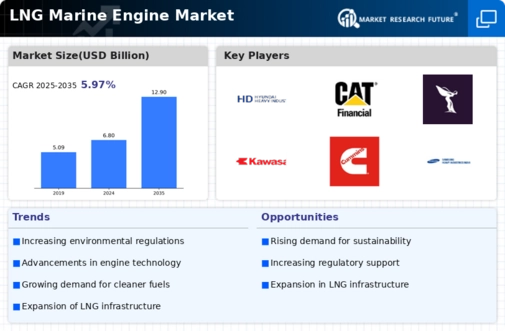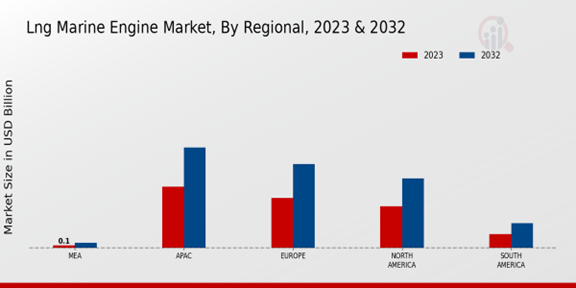Market Growth Projections
The Global LNG Marine Engine Market Industry is projected to experience robust growth, with estimates indicating a market value of 6.8 USD Billion in 2024 and a potential increase to 12.9 USD Billion by 2035. This growth trajectory suggests a compound annual growth rate (CAGR) of 5.97% from 2025 to 2035. The increasing adoption of LNG as a marine fuel, driven by environmental regulations and technological advancements, is expected to play a pivotal role in this expansion. As the industry evolves, stakeholders are likely to focus on enhancing engine efficiency and reducing emissions, further solidifying LNG's position in the marine sector.
Investment in LNG Infrastructure
Investment in LNG infrastructure is a critical driver for the Global LNG Marine Engine Market Industry. The establishment of LNG bunkering facilities and storage terminals is essential for supporting the growing fleet of LNG-powered vessels. Governments and private entities are increasingly investing in infrastructure projects to ensure the availability of LNG as a marine fuel. For instance, several ports worldwide are expanding their LNG bunkering capabilities to accommodate the rising number of LNG-fueled ships. This infrastructure development not only enhances the feasibility of LNG adoption but also encourages shipowners to invest in LNG marine engines, thereby stimulating market growth.
Economic Growth in Emerging Markets
Economic growth in emerging markets is contributing positively to the Global LNG Marine Engine Market Industry. Countries in Asia-Pacific and Latin America are expanding their shipping capacities to support increasing trade volumes. As these economies grow, there is a corresponding rise in demand for efficient and environmentally friendly marine transportation solutions. LNG marine engines are being adopted in new vessels to capitalize on their operational advantages. This trend is further supported by investments in port infrastructure and LNG bunkering facilities, which facilitate the use of LNG as a marine fuel. The market is likely to benefit from this economic momentum in the coming years.
Increasing Environmental Regulations
The Global LNG Marine Engine Market Industry is experiencing a surge in demand due to stringent environmental regulations aimed at reducing greenhouse gas emissions. Governments worldwide are implementing policies that favor cleaner fuels, such as LNG, over traditional marine fuels. For instance, the International Maritime Organization has set ambitious targets to halve greenhouse gas emissions by 2050. This regulatory landscape is likely to drive the adoption of LNG marine engines, which are known for their lower emissions. As a result, the market is projected to reach 6.8 USD Billion in 2024, reflecting a growing preference for sustainable marine solutions.
Technological Advancements in LNG Engines
Technological innovations in LNG marine engines are propelling the Global LNG Marine Engine Market Industry forward. Recent advancements in engine efficiency, fuel storage, and propulsion systems have made LNG a more viable option for marine applications. For example, the development of dual-fuel engines allows vessels to switch between LNG and conventional fuels, enhancing operational flexibility. These innovations not only improve fuel efficiency but also reduce operational costs, making LNG an attractive choice for ship operators. As these technologies continue to evolve, the market is expected to grow at a CAGR of 5.97% from 2025 to 2035, reaching an estimated 12.9 USD Billion by 2035.
Rising Demand for Cleaner Shipping Solutions
The Global LNG Marine Engine Market Industry is witnessing an increased demand for cleaner shipping solutions as stakeholders become more environmentally conscious. Shipping companies are under pressure to adopt greener technologies to meet consumer expectations and comply with international regulations. LNG engines, which emit significantly lower levels of sulfur oxides and particulate matter compared to traditional fuels, are emerging as a preferred option. This shift is not only driven by regulatory compliance but also by the potential for cost savings in fuel consumption. Consequently, the market is poised for substantial growth as more vessels are retrofitted or built with LNG propulsion systems.









